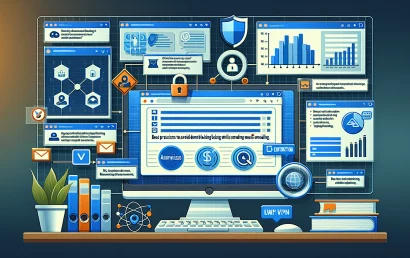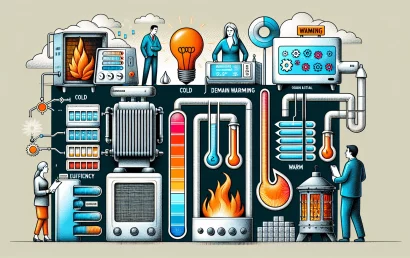Domain Warming: Expert Tips

Email marketing has become an essential tool for businesses looking to reach their audience effectively. However, one of the critical aspects of successful email campaigns is ensuring that your domain is properly warmed up before sending out mass emails. Domain warming is the process of gradually increasing the volume of emails sent from a new or dormant domain to establish a positive reputation with email service providers (ESPs).
In this article, we will explore expert tips on how to effectively warm up your domain, ensuring that your emails land in the inbox rather than the spam folder. Whether you're launching a new email marketing campaign or reviving an old domain, understanding the fundamentals of domain warming is crucial for achieving optimal results.
Understanding Domain Warming
Before diving into the strategies for warming up your domain, it's essential to understand why this process is necessary. Domain reputation plays a significant role in email deliverability. If your domain is new or has a history of sending spammy emails, ESPs will be wary of your messages. A poor reputation can lead to your emails being filtered out or sent straight to the junk folder.
The Importance of a Gradual Approach
One of the key principles of domain warming is to take a gradual approach. This means starting with a small volume of emails and slowly increasing it over time. By doing so, you allow your domain to build a positive reputation with ESPs, which can significantly improve your email deliverability rates.
“A gradual increase in email volume helps establish trust with email providers, minimizing the risk of being marked as spam.” — Email Marketing Expert
Best Practices for Warming Up Your Domain
Here are some expert-recommended practices to effectively warm up your domain:
- Start Small: Begin your email campaign by sending a limited number of emails, perhaps to your most engaged users or a select group of subscribers.
- Increase Gradually: After a week or two, gradually increase the volume of emails you send each day, monitoring engagement rates and deliverability closely.
- Focus on Engagement: Aim to send content that encourages interaction. Higher engagement rates signal to ESPs that your emails are valuable, boosting your reputation.
- Monitor Metrics: Keep an eye on key performance indicators (KPIs) such as open rates, click-through rates, and bounce rates to assess how well your domain warming efforts are performing.
By following these best practices, you can ensure that your domain warms up effectively, paving the way for successful email marketing campaigns in the future.
Main advantages and disadvantages
Advantages of Domain Warming
Warming up your domain before launching email campaigns comes with several advantages that can significantly impact your email marketing success:
- Improved Deliverability: A well-warmed domain is more likely to land in the inbox rather than the spam folder, increasing the chances of your emails being seen by recipients.
- Enhanced Sender Reputation: Gradually building your sending volume helps establish a positive sender reputation with email service providers, which is critical for long-term email success.
- Better Engagement Rates: By focusing on engaged users during the warming process, you are likely to see higher open and click-through rates, leading to more successful campaigns.
- Reduced Risk of Blacklisting: A slow and steady approach minimizes the risk of your domain being flagged or blacklisted by ESPs, which can happen if you send too many emails too quickly.
Disadvantages of Domain Warming
While domain warming has many benefits, there are also some potential drawbacks that marketers should consider:
- Time-Consuming: The warming process can take several weeks, which may delay the launch of your email campaigns.
- Requires Monitoring: Continuous monitoring of metrics and engagement is necessary during the warming phase, which can be resource-intensive.
- Initial Low Engagement: In the early stages of warming, engagement rates may be lower as you are reaching out to a limited audience, which can be discouraging.
- Potential for Missteps: If not executed properly, domain warming can backfire, leading to deliverability issues or damage to your sender reputation.
Understanding both the advantages and disadvantages of domain warming can help you make informed decisions and implement effective strategies for your email marketing campaigns.
Thematic table
| Aspect | Description | Best Practices | Common Mistakes |
|---|---|---|---|
| Definition of Domain Warming | The process of gradually increasing the volume of emails sent from a new or dormant domain to establish a positive reputation with email service providers. | Understand the importance of starting slow and progressively increasing volume. | Sending a large volume of emails immediately. |
| Duration | Typically takes several weeks to properly warm up a domain. | Plan for a gradual increase in sending volume over a 4-8 week period. | Rushing the warming process. |
| Email Volume | Start with a small number of emails and increase gradually. | Begin with 10-50 emails per day, increasing by 10-20% each week. | Sending thousands of emails on the first day. |
| Target Audience | Focus on your most engaged users during the warming phase. | Send emails to subscribers who have recently interacted with your content. | Including unengaged or inactive users early on. |
| Monitoring Metrics | Track key performance indicators to assess the warming process. | Monitor open rates, click-through rates, bounce rates, and complaints. | Neglecting to review performance metrics regularly. |
| Content Quality | Ensure that the content you send is valuable and engaging. | Create relevant and personalized content to encourage interaction. | Sending generic or low-quality emails. |
| Engagement Strategies | Encourage recipients to interact with your emails. | Use compelling subject lines and clear calls to action. | Ignoring engagement tactics and sending bland emails. |
| Feedback Loops | Utilize feedback from ESPs to improve your email practices. | Sign up for feedback loops to monitor complaints and adjust strategies. | Overlooking the importance of feedback from email providers. |
Let's summarize the category:
Warming up a domain is a critical step for anyone looking to engage in effective email marketing. By understanding the nuances of this process, marketers can significantly enhance their email deliverability and engagement rates. Establishing a positive sender reputation is not just beneficial; it is essential for long-term success in any email campaign.
As highlighted throughout this article, a gradual approach to sending emails is vital. Starting small and increasing the volume over time allows email service providers to recognize your domain as trustworthy. This strategy minimizes the risk of being flagged as spam and improves the chances of landing in the inbox of your recipients.
“Taking the time to warm up your domain is an investment in your email marketing strategy that pays off in the long run.” — Email Marketing Expert
Moreover, focusing on engagement during the warming process cannot be overstated. Sending valuable content to your most engaged subscribers helps build a positive relationship with your audience while simultaneously boosting your sender reputation. Monitoring key performance indicators like open rates and click-through rates will provide insights into the effectiveness of your warming efforts.
Ultimately, by following expert advice and avoiding common pitfalls, businesses can successfully navigate the domain warming process. This will not only lead to better email deliverability but also foster stronger connections with their audience, setting the stage for successful email marketing campaigns in the future.





